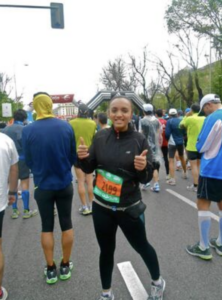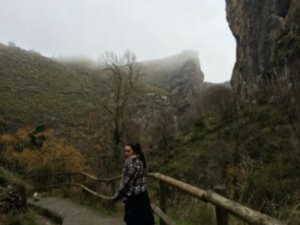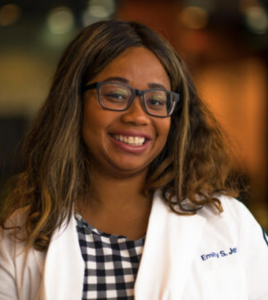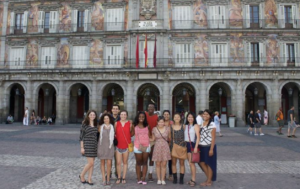Lette Berhe remembering USC Madrid, Fall 2009
My semester in Madrid was my first time living in a “real” city. I loved taking the Metro and seeing all the people in the street at all hours.
Most people didn’t want to go in the Fall semester because of football season. But I’m so glad I did. We got to do a lot more as a group and really get to know all our professors. Paco’s Art History class was one of the best classes I’ve ever taken. We went on lots of class trips to the Prado, which was truly a once-in-lifetime experience.
I’ve been living in Sevilla for 9 years now. But my first time here was a weekend trip with USC Madrid, and I knew I had to come back. I have kept in touch with Loli and always try to meet up with them for the annual trip to Sevilla.
Dimiana Saad remembering USC Madrid, Spring 2013

I lived in a homestay with a 65 year old Spanish Senora who significantly helped me perfect my Spanish because she did not speak any English
I Enrolled in 4 upper division Spanish courses to satisfy my USC Spanish major requirements: SPAN 304- Survey of Fiction, SPAN 320- Iberian and Latin American Cultures: Readings on Society, SPAN 302- Survey of Film, AHIS 496: Paintings in the Prado Museum (my absolute favorite class – I miss the Professor Paco so much!)
I attended classes Mon-Thurs and taught English to a young Spanish girl every Tues and Thurs after class
Some of the highlights of my time at USC Madrid were: discovering the temple of debod (egyptian ruins in the heart of Madrid – I am egyptian and loved seeing cultures collide!) going to Malaga Spain solo and getting to use my spanish, arabic and english there, running A half marathon in madrid!
Alyssa Kennedy reflecting on her time abroad with USC Madrid, 2014

Studying abroad was a humbling, challenging, and fruitful experience. Living independently from my life in the US taught me a lot about myself, my values, and what I wanted to pursue when I returned to the states. I think the most important piece I took away was the humility of living in a new country where I was unfamiliar with many of the customs and separated from my usual comforts. I really appreciate that I’ve had the opportunity to live as an outsider in another country.
My time abroad certainly has contributed to my career path now of becoming psychologist. I have focused much of my graduate training on the importance of culture for psychological treatment. Living in Madrid was one way I learned about the humility of interacting with people who had different identities and were of distinct cultural backgrounds from myself. In a practical sense, living in Madrid also improved my language skills and fluency in Spanish. I used Spanish for even the most minor of daily interactions, which enhanced my comfort speaking and understanding new dialects. These skills have served me in the specialization I am completing now focused on working with Spanish-speaking clients and Latinx communities.
Alumni Student Spotlight: Emily Jetter

My study abroad experience at USC truly shaped the trajectory for my life. My time in Madrid, Spain opened my eyes to the beauty of traveling, culture, and exploration. I knew that my time in Madrid was not complete after my four months abroad with USC. After graduation in 2016, I applied to become an English Teaching Assistant for one year at an elementary school in Madrid. I was responsible for collaborating with the teachers and creating my own lesson plans for my kindergarten class. Additionally, I assisted the sixth grade teachers in preparing their students to take the Cambridge PET exam. Outside of the classroom, I administered private English classes and volunteered with recent immigrants and refugees.
After my second time in Madrid, I decided that I wanted return to Brazil (I completed a Maymester program there in summer 2016). I was lucky enough to find a program called 4YOU2 in Sao Paulo, a company that provided cheap English classes to Brazilians who otherwise could not afford to take an English course. While this was all happening, I was applying to medical school and I could not believe it when I was accepted to my first-choice medical school. Suddenly, I had a big decision to make, postpone medical school or cancel my new job experience in Sao Paulo. This decision may seem easy to some, but it was something that I struggled with for days. However, I knew that I would never have the opportunity to travel to Brazil, experience the lifestyle of the favelas, and meet amazing students and faculty from around the world. I was extremely fortunate that the Admissions Committee at Quinnipiac University were so understanding of my situation and allowed me to defer my admission for one year!
Although teaching in Spain and Brazil may not seem to be directly related to medicine, I definitely think that this experience improved my application. Firstly, my Spanish and Portuguese greatly improved after living there for nine months and these are the two largest non-English speaking populations in Connecticut. Secondly, I gained more experience on working with a team (teachers, principals, parents) which is important because interdisciplinary teamwork is now a fundamental component of medicine. Lastly, even though I primarily worked with younger students, I never used their native language in my classroom. Therefore, I learned the value of explaining complicated material in the simplest way possible so that my students were able to understand me. Ultimately, doctors are teachers and I think it is critical to be able to explain things to patients in a way that they can easily comprehend. As I said in 2016, “There is nothing comparable to leaving your comfort zone and assimilating yourself into a new culture, you will develop in so many ways and make memories that will last a lifetime.” Studying abroad can and will change your life; more importantly, you can still accomplish all of your dreams while being able to have fun along the journey.
Reflections on Madrid: Jennifer Bailey, Fall 2014

My semester in Madrid was, for lack of a better word, indescribable. I had so many new experiences and met so many new people. It is an experience I will never forget, and I am so thankful that I had the opportunity.
I lived in a neighborhood called Lavapies with a host mother, a middle aged woman working for a bank in the neighborhood. My neighborhood was known to be a landing spot for many Spanish immigrants, many of whom had arrived from Africa to enter the European Union. Because of this, I was always surrounded by diversity. It also allowed me to observe first hand an aspect of Spain’s culture, as the country is usually the first stop for many African immigrants who seek refuge in Francophone countries.
I lived in an apartment building, which is very typical of Madrid. Though it was an apartment, my home had two floors and a rooftop terrace, which I often used for studying. It was a living situation I had never encountered in the US, and loved. I would have dinner with my host mother each night and we would discuss our respective days, her telling me about her visits to clients in the outskirts of Madrid and me telling her about my classes.
I took classes at the USC Madrid Center as well as at Carlos III University (Universidad Carlos III). At the USC Madrid Center, I was enrolled in courses in film, theater, and political science. The film and theater classes were taught completely in Spanish, and with my theater class, I was able to take trips to several theaters in Madrid to see plays. The first play was a bit overwhelming with a lot of colloquial dialogue that was hard to follow, but it was a great opportunity to practice Spanish. It was also interesting to compare different aspects of the Spanish theater experience to theater in the US.
At Carlos III University, I took a cultural studies class, a Spanish Golden Age Literature course, and a superior level language class. The university itself provided an interesting experience of cultural immersion, as I was on a campus filled with Spanish students. My professors for these courses were also not affiliated with USC at all, so it was interesting to observe their different teaching styles and grading systems. For example, Spanish courses are graded on a numerical system from 1-10, and a 6 is considered a great grade (of course in the US a 60% doesn’t transfer very well!). This university was also much farther than the USC Madrid Center from where I lived, so taking the train every day to classes allowed me to get more of the local experience. I made an effort while riding the trains to try and understand the Spanish spoken around me, rather than simply listening to my headphones. I actually enjoyed this a lot because the local Spaniards would use a lot of the colloquial phrases I learned in my language class.
Outside of classes, I participated in conversation exchanges, which were a great way to improve my Spanish skills. I would meet up with local Spanish students who wanted to practice their English and just chat, spending half of the time using English and the other half of the time speaking Spanish. I loved helping them with their English, especially because it allowed me to learn firsthand about Spaniards’ perceptions of American culture. Furthermore, practicing my Spanish with them allowed me to get better at my conversational skills. I would have to listen intently to keep up with their speed of speaking, but it made me a much better listener. Additionally, I learned how to speak and have a complete conversation without focusing on every grammatical nuance or vocabulary word. These authentic experiences made me realize that there is a large aspect of language learning that cannot take place in a classroom.
I also spent a great deal of time teaching English to local children. I worked with a total of five children from three families once a week. We would play cards and watch television shows to focus on improving their English levels. Throughout the course of the semester, we would talk about our interests and bond over those that we had in common (a 12 year old girl that I taught was also a huge One Direction fan!). Though the children were between 10 and 13 years old, we developed a sort of friendship that made me sad to leave them in December. Their parents even got me a card and a gift for me to remember the experience by.
The USC Madrid program also took two weekend excursions, to Castile and Leon and Andalusia. In Castile and Leon, we were able to visit Salamanca, Segovia, and Avila. Seeing the historic university in Salamanca and the famous aqueduct in Segovia were incredible experiences. We were also given free time in the afternoon, which I used to try some of the local cuisine of each place. I also got to meet some of the local students in Salamanca, who gave me some insight on going to college in Spain. Our system is actually very different from the Spanish university system in many ways. For example, most college students still live at home with their parents while attending school, and public universities are generally the most prestigious. Another important difference is, of course, the cost. When I told some of the Spaniards I met how much education cost in the United States, they thought I was joking!
In Andalusia, I was struck by how beautiful the scenery was. There were many flowers and fruit trees that I had never seen before that I noticed during our walking tour of Cordoba. The streets were also extremely narrow, which of course reflected the age difference between Spanish and American cities. The Spanish cities I visited seemed to provide a much more intimate feel than American cities I have visited.
I definitely believe that my trip to Spain was as amazing as it was due to our program directors, Luis and Loli. From our first week there, they did their best to make us feel immersed in Spanish culture by providing us with cultural activities each week and many other resources, such as restaurant recommendations, for all of Spain. They gave us advice on how to handle cultural differences and how to make the most of our time in Spain. I think due to their advice, my host mother, the friends I made, and the trips that I went on, I was able to have an amazing study abroad experience and am so thankful that I received the Del Amo grant to make it all possible.
Reflections on Madrid: Leowil Villanueva, Spring 2013

I had finally made it. After so many years of watching television and YouTube videos, being there physically – seeing it with my own eyes, feeling the cool breeze and sunlight on my face, the aroma of locally grown cider filling my nose – was nothing short of surreal. The Picos de Europa National Park was everything I had imagined it would be and more. Actually being there after wanting to experience it for so long, I felt a rewarding sense of fulfillment and accomplishment as I hiked along, looking out over the green forests and white peaks and breathing in the crisp, clean air of that sunny March morning. As I sat on a rock at the bank of the crystal clear Lake Ercina savoring a tortilla española and chorizo sandwich, I realized for the nth time during my semester in Spain that my long-time dream had become reality.
Later that day, strolling around the perfectly preserved medieval towns of Covadonga and Cangas de Onís, I found myself transported through time to the 8th century. I stood before the statue of King Pelayo of the Asturians and felt the history of the land come to life before me. There, nestled in the hills of the Picos de Europa, the history of Spain that I studied in the classroom back here at USC in Los Angeles was real and relevant to me and to our world today. Standing at the birthplace of the Christian Reconquista of the Iberian Peninsula, the beginning of the political processes that would result in the creation of the Kingdom of Spain, whose future empire after the Catholic Kings would forever change the course of world history, I was overwhelmed with a sense of awe and a new appreciation for history and its study.
I credit eye-opening experiences such as this one to the quality of the USC Madrid program. After comparing my travels with USC on day trips to Toledo & Segovia and weekend trips to Andalucía and Galicia with the experiences of other American students abroad, I learned what I believe is the right way to travel and explore foreign cultures. In our program we were completely immersed in the local language-cultural environment both in and outside the classroom and thus were able to better engage the community and appreciate our tours for their historical and artistic value. In contrast, I remember being taken around Lisbon by a friend of a friend who was studying there for a semester. This program was quite different. Students lived in an apartment shared with other English-speaking foreigners and took all their classes in English without taking any Portuguese language class. Many students did not even bother to buy a book for self-study. When this friend hosted us, he had been there for two months already and still did not know anything about the city outside of the expatriate social circles and understood no Portuguese. I am sincerely grateful for the quality of our program and the myriad of cultural-educational experiences it has allotted us.
From my years of self-indoctrinated Spain obsession, it had become a top priority of mine to visit a vineyard and an olive plantation at some point during the semester. Needless to say, I was ecstatic when I heard that these two goals would be met by the USC Madrid program at no extra cost to me. In Córdoba we spent an afternoon touring an olive plantation that won an award for producing some of the world’s best olive oil in 2012. In Santiago de Compostela we toured a vineyard and their processing and storage facilities on site. Both times our hosts gave us an educational tasting session and both times I could not resist bringing some of their food-art home with me as a remembrance. Listening to these people speak with such passion and love for their craft, with such pride and admiration for the long tradition of its production that dates back to antiquity, I found myself in admiration of their dedication and enthralled by their art.
While my classes at USC and my brainwashing at home had prepared me to appreciate Spain’s history, food and culture outside of the classroom, I soon discovered that I had much to learn about the Spanish people and their lifestyle beyond the stereotypical siesta and tapas bar-hopping. In all my interactions with the Spanish people, I have discovered that they are generally very conscious and aware of their history and identity as Spaniards and the role their nation has played in world history. Their pride in their nation’s imperial and cultural legacy is part of being Spanish, a pride that I feel is sometimes lacking in the younger American generation. I learned to appreciate the Spanish love of people and their willingness to take time for each other. Although their passion for fun and sociality in other cultural contexts is often interpreted as laziness or a lack of drive and ambition, I have seen that this laid back lifestyle reflects the importance they place on human relationships and community. Their friendliness, warmth and openness helped me to feel comfortable with them and really relate to them. Of everything that I saw in Spain, from the architecture and natural beauty, to the food, art and history, my most memorable experiences are those with the Spanish people. I will particularly miss walking home from a tapas bar at night and passing by a group of senior ladies waiting for their bus, huddling together for warmth in their long faux fur coats chatting up a storm next to a crowd of trendy youth gossiping about their high school crushes. Other common scenes come to mind, but that would be another essay.
The end of the semester came too soon. While I was more than ready to come home to the U.S. to be with family, I was nowhere near prepared to part with my new home, or rather, the place I had already felt was home before ever even having been there before. Although I was able to accomplish most of the goals I had set for myself, there were still several that nagged at me and many more new ones I had developed there. I travelled throughout the Iberian Peninsula from Valencia in the east to Salamanca in the west, from Granada in the south to San Sebastián in the north, but there were more places I disappointedly realized I had yet to go: Navarra, Aragón, the Balearic and Canary Islands. I had sampled dishes of all sorts that I had only seen on T.V., but there were plenty more that I had yet to try. I have resolved to save them for my next visit.
Though these factors did sit heavy on my conscious, I was able to leave Spain satisfied with all I was able to do. One semester in Spain, while insufficient to satisfy my Spain addiction, undeniably and significantly improved my Spanish language comprehension, speaking, reading and writing skills. I am now confident in my ability to communicate with native Spanish speakers in both a casual, conversational context and a more formal, professional setting. This newfound confidence in Spanish also gave me a confidence and independence to handle myself travelling abroad alone outside of the program. Through these travels I have also improved my ability to interact with people from different cultural backgrounds and have learned to better appreciate our differences. Before I ever went to Spain, I brainwashed myself to love its culture, food, people, history and places. After one semester there, I have fallen even more in love with the country and its people and have left a part of it there with me. Now that I am back here in the U.S., I have again resorted to YouTube, the Travel Channel, Spanish news and radio to get my daily dose of Spain and prevent the serious consequences of untreated Spain withdrawal syndrome. I had the time of my life. I learned about myself and connected with the Spanish side of my heritage. I now know I have another place I can call home. Thank you USC Dornsife Overseas, USC Madrid and the Del Amo Fund for helping to realize my long-time dream and making it more than I could have hoped it to be.